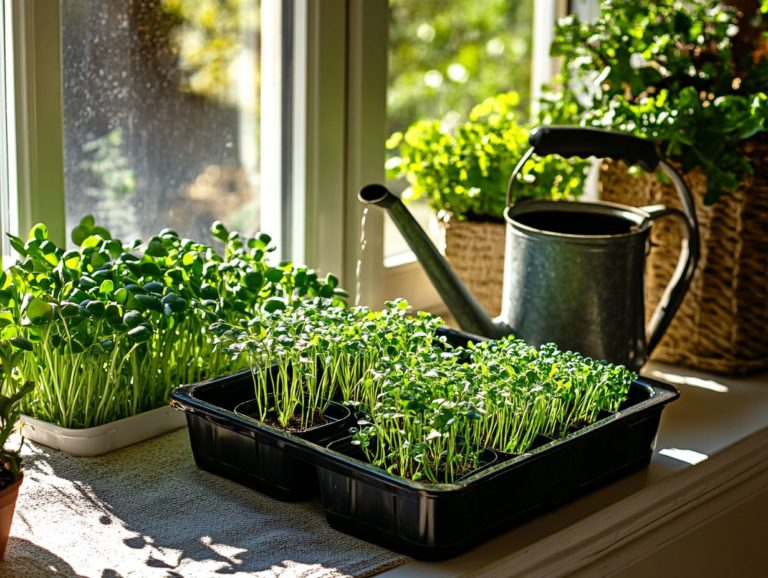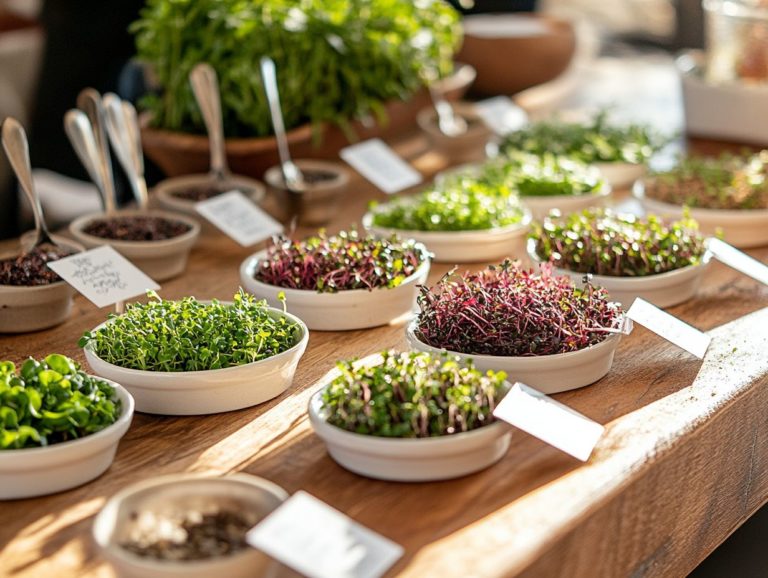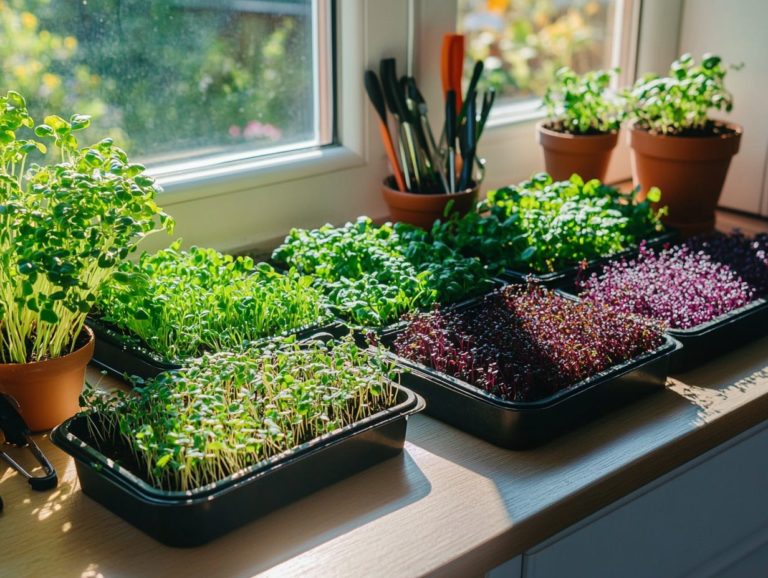What Are the Most Nutritious Microgreens?
Microgreens are tiny, vibrant plants that are packed with flavor and nutrients. They can be an exciting addition to your diet.
These greens offer impressive nutritional benefits, including high nutrient density and powerful antioxidants. They can greatly enhance your well-being.
Explore popular microgreen types like Kale, Radish, Pea Shoots, Broccoli, and Sunflower. Learn how to easily grow them in your own home!
Discover delicious recipes and expert tips to incorporate these nutrient-packed greens into your meals. Enjoy maximum health benefits!
Dive in to see how microgreens can elevate both your culinary creations and your wellness journey.
Contents
Key Takeaways:
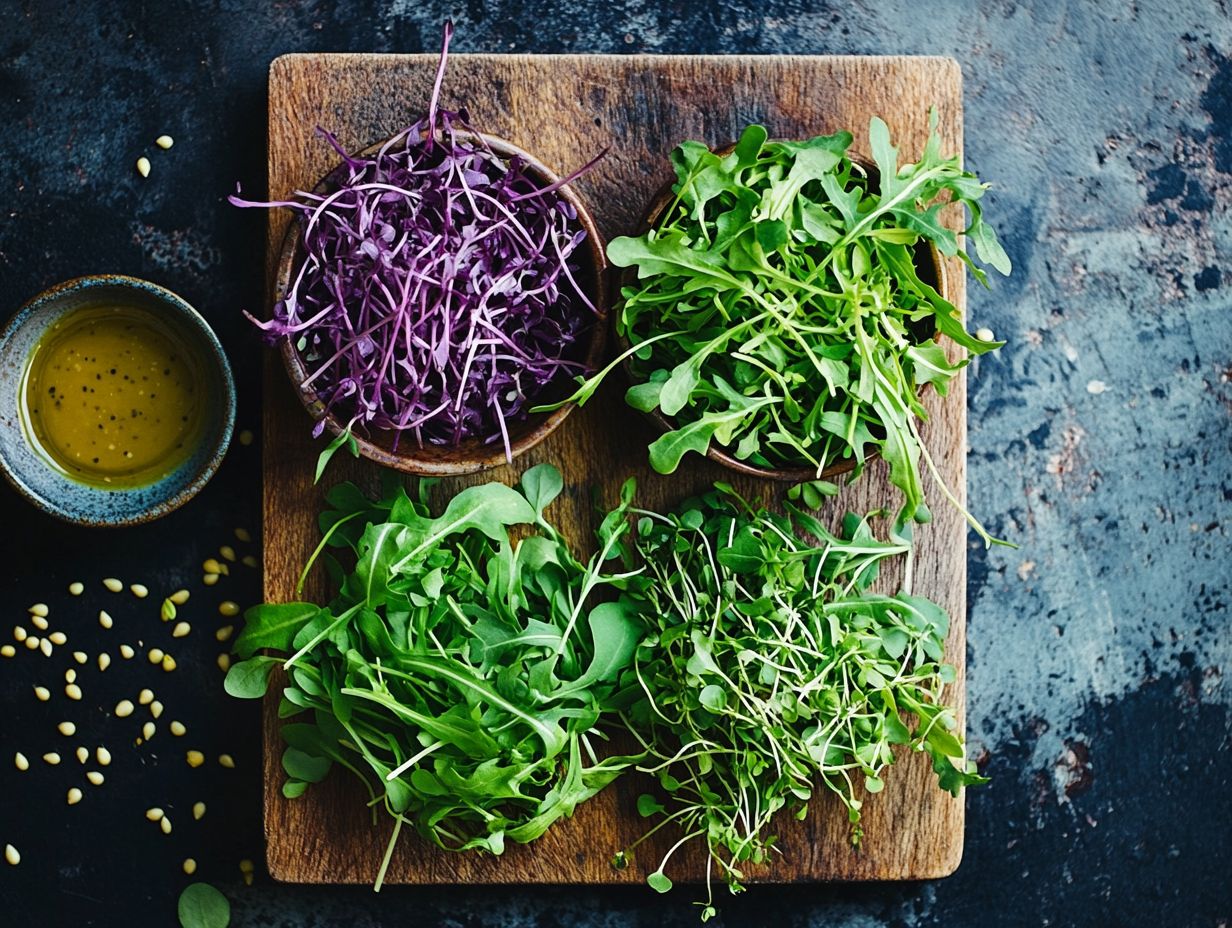
- Microgreens are rich in nutrients and offer various health benefits.
- Different types of microgreens have unique nutrient profiles. Incorporating a variety is important!
- Growing microgreens at home is an easy and affordable way to boost your nutrient intake with organic or non-GMO seeds.
What are Microgreens?
Microgreens are young, edible plants harvested just after their first true leaves appear. They represent a vibrant growth stage for various vegetables and herbs.
These tiny greens are not only easy to grow but also eco-friendly. They help urban gardeners reduce food waste while enhancing their diets.
Microgreens boost both the visual appeal of dishes and provide impressive nutritional benefits. They often have higher concentrations of vitamins and minerals compared to fully grown plants.
Adding microgreens to your meals enhances flavor and promotes a healthier lifestyle without sacrificing taste.
Nutritional Benefits of Microgreens
Microgreens are more than garnishes; they are nutritional powerhouses. Research shows they contain higher levels of vitamins and antioxidants than mature vegetables.
Incorporating a variety of microgreens can significantly boost your health with beneficial compounds.
High Nutrient Density
The high nutrient density of microgreens makes them a fantastic addition to your diet. They provide a concentrated source of essential vitamins and minerals.
Many microgreens, like Kale and Broccoli, have higher nutrient levels than their mature counterparts. This is a great choice for anyone wanting to maximize their health benefits.
Microgreens can contain up to six times more vitamin C than mature vegetables. Varieties like Radish and Pea Shoots are rich in antioxidants, contributing to your overall well-being.
Adding microgreens to your meals boosts flavor and enhances your nutritional profile, supporting immunity and promoting a healthy diet.
Antioxidant Properties
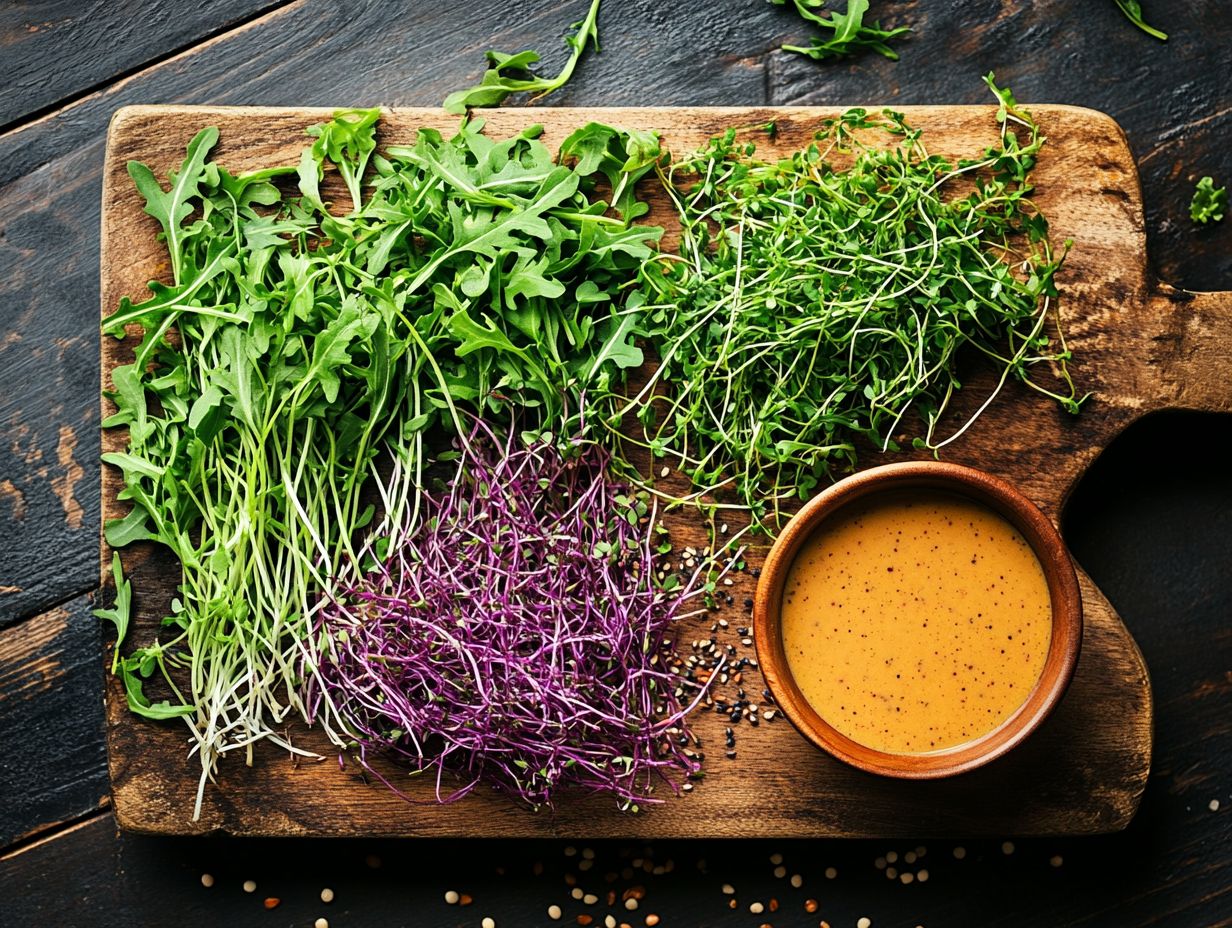
Microgreens are known for their strong antioxidant properties. They help promote health and prevent disease. The antioxidants found in varieties like Radish Microgreens and Sunflower Shoots effectively combat oxidative stress and inflammation. These delightful greens are an excellent choice for anyone seeking to bolster their immune system and enhance overall well-being.
These tiny powerhouses deliver a significant nutritional punch. They often boast higher levels of vitamins and minerals compared to their mature counterparts. For example, Broccoli Microgreens are packed with sulforaphane, a compound found in broccoli that may have cancer-fighting properties, while Kale Microgreens provide generous amounts of vitamins A, C, and K, essential for maintaining healthy skin and vision. If you’re curious about which varieties to include in your meals, check out this guide on what microgreens are best for salads.
Looking for tasty ways to boost your health? Adding microgreens to your meals is a delicious solution! Integrating microgreens into your daily diet offers a nutritious and delicious way to increase your antioxidant intake. If you’re curious about which types to include, check out the top microgreen varieties for health. Whether in salads, smoothies, or sandwiches, just a sprinkle of these vibrant greens effortlessly elevates your everyday meals.
Specific Nutrient Profiles
Each type of microgreen has its own distinct nutrient profile. They offer unique health benefits that can elevate your diet. For instance, Pea Shoots are bursting with vitamins A and C. Broccoli Microgreens are loaded with sulforaphane, celebrated for its remarkable health-promoting properties. This diversity among microgreens is truly impressive.
Radish Greens are a powerhouse of vitamins K and C. These vitamins can support bone health and strengthen your immune system, respectively. Meanwhile, Sunflower Microgreens are brimming with vitamin E, a potent antioxidant that helps protect your cells from oxidative stress. For those interested in expanding their gardening, understanding what the seasonal microgreens to grow can enhance your health and gardening experience.
Let’s not forget Beet Microgreens. They are rich in betalains, natural pigments that offer health benefits and support heart health. By incorporating these microgreens into your meals, you’re enhancing flavor and texture. If you’re curious about other options, you can explore the best microgreens for smoothies as well. You’re also indulging in a snack rich in essential nutrients and beneficial compounds while supporting your overall well-being.
Types of Microgreens
Microgreens present a delightful array of options. They include flavourful greens like Kale and Radish, each bringing distinct flavors and nutritional advantages that elevate your meals and support a healthy lifestyle.
Varieties like Kale Microgreens, Radish Microgreens, Pea Shoots, Broccoli Microgreens, and Sunflower Shoots infuse your dishes with vibrant colors. They also deliver an impressive nutritional boost.
Incorporating these little powerhouses into your culinary repertoire is essential for both taste and wellness. They allow for creative culinary uses.
Popular Varieties and Their Nutritional Value
Among the vast selection of microgreens, certain varieties truly shine for their impressive nutritional benefits and culinary versatility. Take Kale Microgreens, for example; they re packed with vitamins A, C, and K and bring a robust flavor to the table. Radish Microgreens are known for their peppery kick and high antioxidant levels, making them a favorite for salads and garnishes.
Don’t overlook other stellar options like Broccoli Microgreens. They are celebrated for their cancer-fighting properties and subtle earthy flavor. If you’re wondering what seeds you can use for microgreens, Sunflower Microgreens, with their delightful crunch, also deserve your attention. They offer a fantastic source of healthy fats and protein.
Incorporating these nutrient-dense greens into your daily meals can be both simple and delicious. Tossing them into smoothies not only boosts nutritional value but also enhances taste and texture. You can also use these microgreens as an eye-catching topping for sandwiches or wraps. Elevate your everyday dishes while delivering a burst of flavor and health benefits.
Don’t miss out on these health benefits start adding microgreens today!
Growing Microgreens at Home
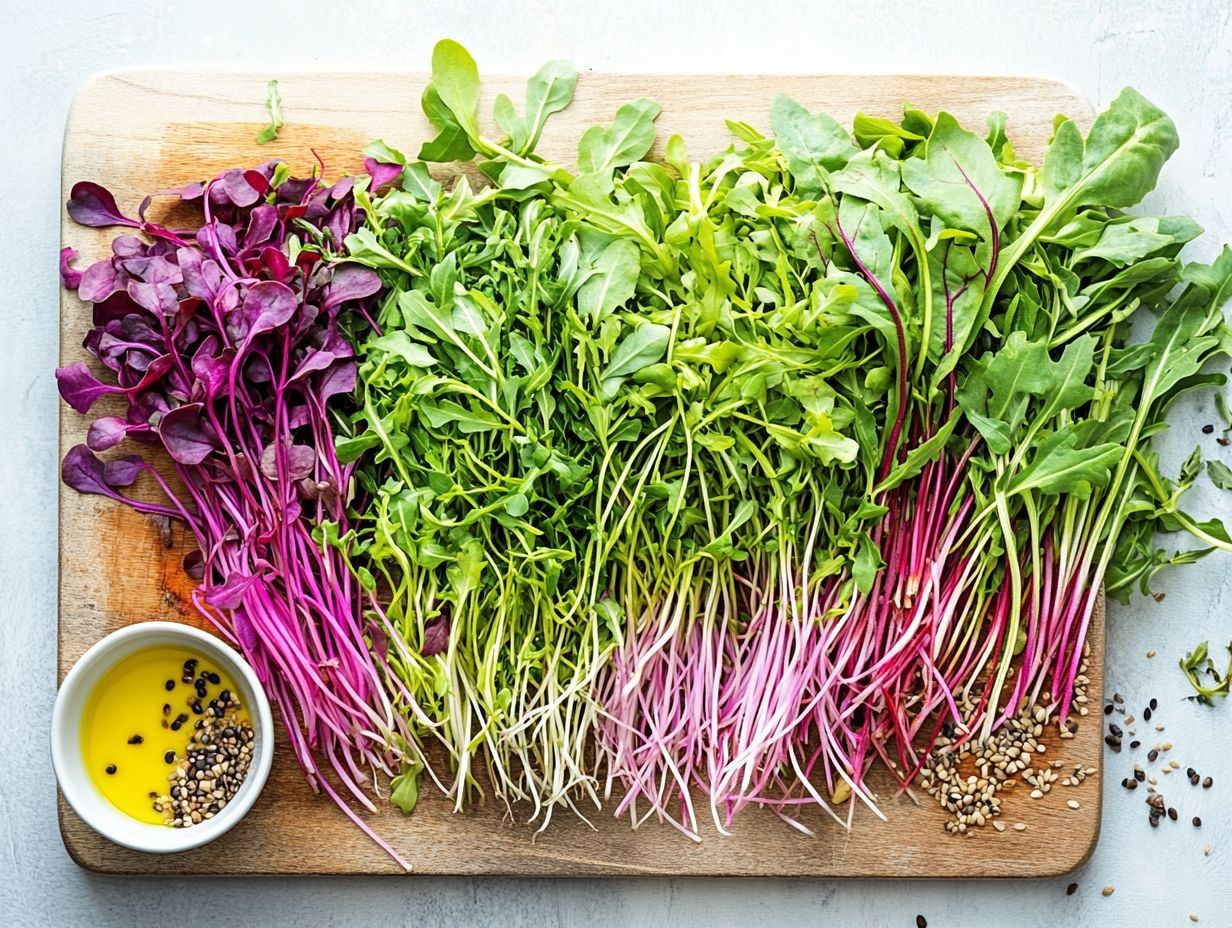
Growing microgreens at home offers a satisfying and simple way to enjoy fresh, nutritious greens straight from your kitchen. With the right knowledge about selecting seeds, choosing the ideal growing medium, and ensuring sufficient moisture, light, and temperature, you can cultivate a variety of microgreens think Kale, Radish, and Broccoli even in limited spaces.
Whether you’re an urban gardener or a health-conscious enthusiast, this endeavor is both accessible and fulfilling.
Step-by-Step Guide
To successfully grow microgreens at home, follow this straightforward step-by-step guide for a bountiful harvest of these nutrient-packed greens. Start with organic or non-GMO seeds and prepare your growing medium by ensuring it s moist and ready for sowing.
Next, provide adequate lighting and maintain the right temperature and humidity for optimal growth. Choose varieties that match your taste and culinary ambitions, like radish, kale, or basil. When sowing, sprinkle the seeds evenly over the moistened soil, gently pressing them down for good contact, then cover them with a thin layer of growing medium.
Regularly monitor moisture levels; the ideal environment keeps the soil damp but not waterlogged. For proper lighting, consider using a grow light that offers the necessary spectrum, especially on shorter winter days. Keeping the temperature between 65 F and 75 F fosters healthy growth.
If you experience issues like leggy plants or mold, adjusting the light distance or enhancing air circulation can resolve these problems, ensuring a robust microgreen crop.
Incorporating Microgreens into Your Diet
Incorporating microgreens into your diet is a delicious way to enhance your nutritional intake and elevate your meals. These vibrant greens can be added to a range of culinary creations, from fresh salads and hearty sandwiches to invigorating smoothies and elegant garnishes.
Microgreens are a versatile ingredient for anyone looking to embrace a healthy eating lifestyle.
Recipe Ideas and Tips for Maximum Nutrient Absorption
Creating meals with microgreens is an excellent way to enjoy their health benefits while maximizing nutrient absorption. Add them to dishes like salads, wraps, and smoothies to elevate flavors and enhance nutrition. As a health-conscious consumer, you can capitalize on these remarkable superfoods, including Broccoli Microgreens and Sunflower Shoots.
Microgreens like arugula, Radish Microgreens, and Broccoli Microgreens are packed with vitamins, minerals, and antioxidants. For instance, adding a handful of nutrient-dense Pea Shoots to your salad enriches it with flavor and health benefits. If you’re curious about which microgreen varieties are best for juice, be sure to check out this helpful guide.
In wraps, layer microgreens with lean proteins like grilled chicken or tofu for a satisfying meal that nourishes your body while tantalizing your taste buds. Blending microgreens into your smoothies increases nutritional value and adds a refreshing twist, especially with spinach or quinoa. To learn more about their benefits, check out what nutrients do microgreens provide?
To boost nutrient absorption, pair these greens with healthy fats like avocado or nuts. This combination enhances the uptake of fat-soluble vitamins, making them even more beneficial to your overall diet, especially when using non-GMO seeds.
Frequently Asked Questions
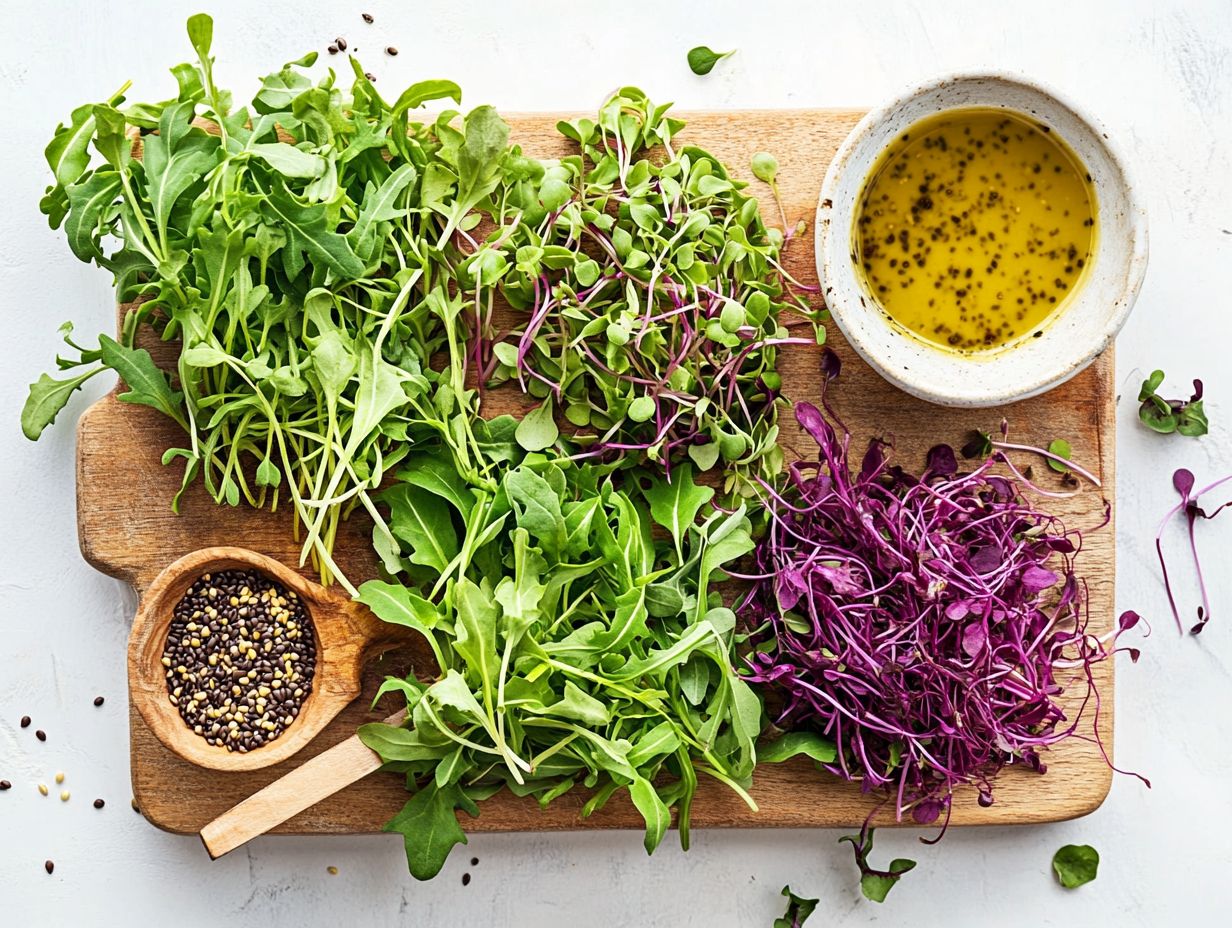
What are the most nutritious microgreens?
The most nutritious microgreens include Broccoli Microgreens, Kale Microgreens, Radish Microgreens, Pea Shoots, Sunflower Shoots, and cilantro.
Don t miss out on the chance to enhance your meals with these vibrant greens! Start your journey in growing and enjoying microgreens today!
What makes these microgreens so nutritious?
Microgreens are considered more nutritious than their fully grown counterparts because they are harvested at an earlier stage. At this time, their nutrient content is at its peak.
Are microgreens a good source of vitamins and minerals?
Absolutely! Microgreens are an excellent source of essential vitamins and minerals, including vitamins A, C, and K, along with iron, potassium, and calcium. You can find this in the USDA National Nutrient Database.
Do microgreens have health benefits?
Yes! Microgreens are linked to health benefits like improved digestion, a stronger immune system, and a reduced risk of chronic diseases.
How should I incorporate microgreens into my diet?
Add microgreens to your salads, sandwiches, or smoothies for a crunchy, tasty twist! They serve as a versatile and flavorful addition to any meal.
Are all microgreens equally nutritious?
No, the nutrient content of microgreens varies depending on the type of plant, growing conditions, and harvesting methods. For example, seed priming, which is soaking seeds in water before planting, can enhance nutrient content. Choose a variety of microgreens today to supercharge your meals with nutrients!



